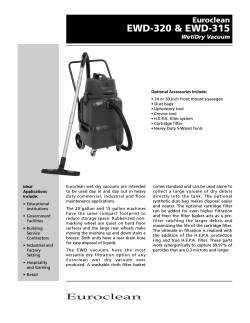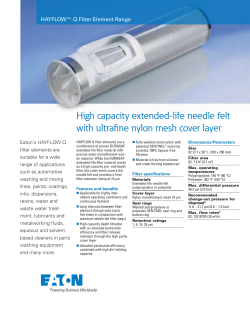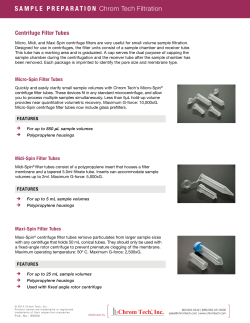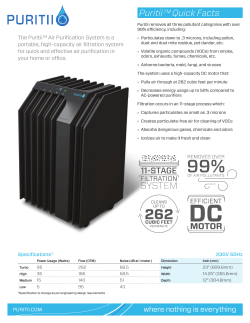
Filtration Methods - Wiley Online Library
Filtration Methods SIEGFRIED RIPPERGER, Gonbach, Germany WALTER G€oSELE, Heidelberg, Germany CHRISTIAN ALT, M€unchen, Germany THOMAS LOEWE, Sartorius Stedim Biotech GmbH, G€ottingen, Germany Filtration is the separation process of removing solid particles, microorganisms or droplets from a liquid or a gas by depositing them on a filter medium also called a septum, which is essentially permeable to only the fluid phase of the mixture being separated. The particles are deposited either at the outer surface of the filter medium and/or within its depth. The permeation of the fluid phase through the filter medium is connected to a pressure gradient. The liquid more or less thoroughly separated from the solids is called the filtrate, effluent, permeate or, in case of water treatment, clean water. As in other separation processes, the separation of phases is never complete: Liquid adheres to the separated solids (cake with residual moisture) and the filtrate often contains some solids (solids content in the filtrate or turbidity). The purpose of filtration may be clarification of the liquid or solids recovery or both. In clarification the liquid is typically a valuable product and the solids are of minor quantity and are often discarded without further treatment. If however, the solids are to be recovered, they very often have to be washed, deliquored and dried (see Fig. 1). In this article, washing means the cleaning of a product (filter cake) and it is distinguished from cleaning parts of the filter itself, which will be called rinsing (e.g., rinsing a filter screen or a filter cloth by jets of water). A further distinction is to be made between washing and extraction or leaching. Washing eliminates liquid contaminants from the pores between the particles of a filter cake. Extraction recovers soluble matter out of the solid particles themselves. The term drying means thermal drying, while the elimination of liquid from the filter cake by mechanical forces is called deliquoring or dewatering, e.g., deliquoring by a pressurized gas or by expression. # 2015 Wiley-VCH Verlag GmbH & Co. KGaA, Weinheim 10.1002/14356007 Filtration processes can be classified in accordance with different criteria: 1. Location of particle retention. The particles can be separated on the outer surface of the filter medium (surface filtration, cake filtration) or inside of the filter medium (depth filtration, deep bed filtration) 2. Generation of the pressure difference. Pressure filtration, vacuum filtration, gravity filtration, centrifugal filtration 3. Operation mode. discontinuous, continuous, quasi-continuous. Dynamic filtration and static (normal) filtration. In case of dynamic filtration are during the filtration process mechanisms active which helps to reduce the build-up of a filter cake. The most common dynamic filtration process is cross-flow-filtration 4. Application. For example water filtration, beer filtration Filtration is effected by application of a pressure difference which can be produced by a pressurized fluid, by a vacuum, by the gravity or by centrifugal force (see Fig. 2). Pressure filtration typically requires a pump for delivering the suspension to the filter. Vacuum filtration requires a vacuum pump. The pump evacuates the gas from a filtrate receiver, where the filtrate is separated from the gas. The filtrate is drained either by a barometric leg of at least 8 to 10 m or by a pump that is able to run on snore (i.e. with a deficiency of feed liquid so that it tends to draw in air). In some cases the liquid is allowed to flow through the filter medium only by gravity (gravity filtration). Centrifugal filtration is done in perforated centrifuge rotors. In case of vacuum filters the cake is freely accessible. This facilitates automatic cake 2 Filtration Methods Figure 1. Solids processing chain Figure 2. Driving forces in filtration handling. However, vacuum filters cannot handle hot liquids, or solvents with high vapor pressure. The pressure difference across vacuum filters is very limited, and the residual moisture of the filter cake is higher than with pressure filters. Pressure filters allow high pressure differences. They are preferred when the product must be kept in a closed system for safety reasons, or if the residual moisture content is important. The handling of the filter cake is obviously more difficult in a pressure filter. Filtration by centrifugal force requires more technical equipment, but as a general rule it yields solids with lower residual moisture. During a dynamic filtration the collected solids on the filter media are continuously removed, mostly with a tangential flow to the filter medium (cross-flow filtration). Crossflow filtration is a standard operation with membranes as a filter medium. The flow parallel to the filter medium reduces the formation of a filter cake or keeps it at a low level. So it is possible to get a quasi-stationary filtrate flow for a long time. Various models have been developed to describe the physical process of filtration. This chapter concentrates on four idealized filtration models depicted in Figure 3. Cake filtration is the most frequently used model. Here it is assumed that the solids are deposited on the upstream side of the filter medium as a homogeneous porous layer with a constant permeability. As soon as the first layer of cake is formed, the subsequent filtration takes place at the top of the cake and the medium provides only a supporting function. Thus, if the flow rate dV/dt is constant, the pressure drop will increase linearly, proportional to the quantity of solid deposited. This model can be applied especially for all hard, particulate solids. Blocking Filtration. The pressure drop is caused by solid particles blocking pores. Soft, gelatinous particles retained by a sieve exhibit such a behavior. If the flow rate dV/dt is constant, the pressure drop increases exponentially with the quantity filtered, the number of open pores asymptotically approaching zero. The pores may belong to a filter medium (screen or filter layer) or it may be pores within a filter cake of coarse particles, which are blocked by migrating fine particles. Filtration Methods 3 Figure 3. Filtration models Deep Bed or Depth Filtration. Solid particles are retained in a deep filter layer. This takes place for example in sand filters for clarification of drinking water, which retain even colloidal particles. The typical effect of deep bed filtration is adhesion of solids to the grains of the filter layer. Only rather big particles are retained by the screening effect. When the filter bed has been saturated with solids, the solids concentration in the filtrate leaving the bed progressively approaches that of the incoming suspension. Cross-Flow Filtration. In cross-flow filtration the suspension flows with high speed tangentially to the filter medium surface, preventing the formation of a filter cake. Only a small flow of liquid passes through the filter medium. A certain layer of solids accumulates in the boundary layer on the filter surface, and reduces the flow of filtrate. After an initial period, a dynamic equilibrium is established between convective transport of solids to the filter surface and removal of solids by hydrodynamic forces acting on the particles due to turbulence and diffusion. Surface filtration is the antonym to depth filtration. The solids are retained on the surface of a filter medium. Generally the models of cake filtration or of blocking filtration can be applied. Screening designates a classification process, which retains the particles below a certain size and lets pass the smaller ones through the openings of the screen. Often the term screening-filtration is also used to designate a surface filtration with a screen as a filter medium. Its mode of action resembles screening (or straining) as long as the filter medium is clean, but it is clearly a cake filtration as soon as a layer of solids has formed.
© Copyright 2025









